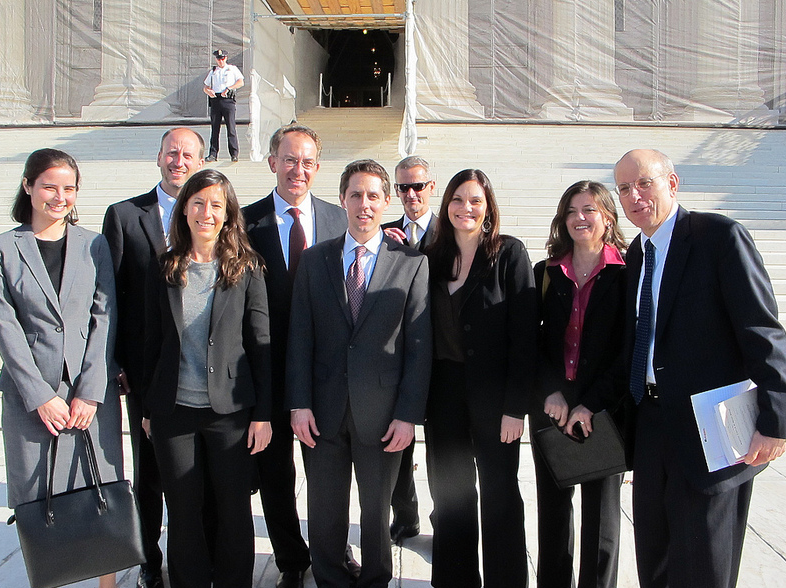Leading the Way on Stormwater Pollution Solutions
HOW LA Waterkeeper's LITIGATION SPURRED LA COUNTY'S SAFE CLEAN WATER PROGRAMsEPTEMBER 29, 2022Attorneys from LA Waterkeeper and NRDC at the US Supreme Court
With the 50-year anniversary of the Clean Water Act less than one month away, LA Waterkeeper is taking this moment to celebrate the many victories this landmark law has helped our small but mighty team secure for the benefit of all Angelenos. Today, we’re taking a look at how one lawsuit made a big difference in curbing our region’s top source of water pollution.
In 2008, LA Waterkeeper and the Natural Resources Defense Council (NRDC) sued Los Angeles County and the LA County Flood Control District for ongoing violations, taking the case all the way through a US Supreme Court review in 2012. In 2015, a district court found the County responsible for 497 violations of the permit for allowing discharges to contaminate the Los Angeles and San Gabriel Rivers and areas designated as having biological significance in Malibu. In the settlement agreement, the County agreed to pay $2.8 million towards green street infrastructure in Watts and $1.2 million to support residential retrofits such as rain gardens and cisterns to capture and filter runoff throughout the region.
Urban and stormwater runoff is the leading source of pollution to LA’s waterways. Even on a dry day, up to 100 million gallons of untreated contaminated runoff fouls our rivers, creeks and coastal waters. Who hasn’t, on a lazy walk through their neighborhood, witnessed dirty water from overwatering lawns, car washing, or a business hosing down muck from its parking lot flowing into storm drains? A single storm event can send five billion gallons of water tainted with toxins down our storm drains and into our waterways. Combined, an astounding 100 billion gallons of polluted runoff is estimated to flow into our waterways annually, wasting what could instead be an invaluable source of water for our thirsty county.
And this runoff has myriad short- and long-term impacts on wildlife and our marine environment; on human health, where studies have shown hundreds of thousands of people get sick annually from swimming near storm drain outfall pipes; and on our financial health, costing tens of millions or more annually due to the impact of beach advisories on our tourist-driven economy as well as public health and cleanup costs.
The LA River pushes runoff out to the ocean instead of capturing storm water to replenish aquifers.
This systemic problem is hard to address due to the massive amount of concrete and pavement in LA, which doesn’t allow water to filter into the ground and recharge our aquifers as nature intended. With so much water that had nowhere to go, water managers of decades past turned to channelizing our inland waters and creating a storm drain system intended to move water out of our communities as quickly as possible to avoid flooding. The result of this engineered system was a superhighway for untreated polluted water. Runoff carries pesticides and herbicides from our lawns; oils and grease from our roads; heavy metals and a host of toxic chemicals – including emerging ‘forever chemicals’ like PFAS - from industrial facilities; and trash, bacteria, and other contaminants from throughout our communities. The sheer volume and diversity of the pollutants also makes this urban slobber hard to treat.
But that doesn’t mean our local governments and agencies can simply pass on addressing the problem. And that’s the real legacy of the suit LA Waterkeeper and NRDC brought against our local agencies to tackle this problem almost 15 years ago.
While the direct investments in the community-based stormwater projects highlighted above was relatively small, this lawsuit is credited by many (including within County offices and departments) as the impetus for the transformational $280M/year Safe Clean Water Program. Measure W, which established the Safe Clean Water Program, was a county-led ballot measure that was passed by voters in 2018 with nearly 70% of the vote. This program is funding nearly $280 million annually in perpetuity for multi-benefit clean-water investments that collect and treat stormwater to improve the health of local waterways, use runoff to enhance local water supplies, and increase nature-based infrastructure like parks and green streets in communities desperately in need of greenspace.
“In 2018, LA County voters chose to tax themselves to invest in green infrastructure that would clean up our urban storm runoff, improve the health of our waterways, increase our local water sources, and make local communities more resilient. The foundation for this historic investment comes from the legal battles that LA Waterkeeper has fought to hold California and its jurisdictions accountable to building a more sustainable water future. LA Waterkeeper has been a key partner in making sure that we are building and following through on important and actionable solutions.”
This is a great example of how a lawsuit can drive hugely impactful public policy decisions that live long after – and can even be far greater in scope - than the initial suit....and how a small but mighty group like LA Waterkeeper can use the law to have a massively outsized impact in promoting a more resilient and equitable water future for the Los Angeles region.



